
IT’S WAR in the bush, at least when it comes to dual-cab utes, and the latest weapon of choice is the V6 turbo-diesel. Ending an era dominated by four cylinders – and a rampant five-pot – Volkswagen unleashed its V6 Amarok on the emerging top-end dual-cab market in 2016. It’s something newcomer Mercedes-Benz couldn’t let slide, with a new arrival – the X350d – that sets up the ultimate German duel.
In decades of taking to the bush, Australians have largely relied on Japanese vehicles to get them out and back again. Even utes – once the domain of local manufacturers – are these days largely the domain of the Japanese. But Europe is fighting back, and big power is the artillery.
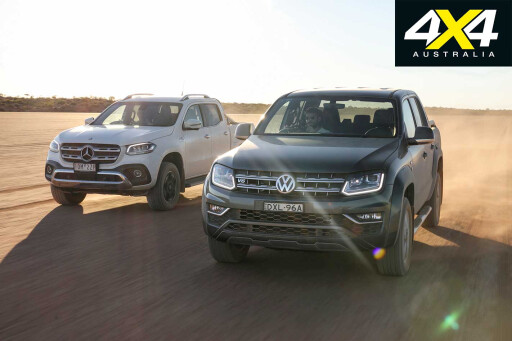 Those spending big on the Amarok Ultimate now get a performance upgrade in the form of a more potent tune from the 3.0-litre V6 turbo-diesel, something that brings a 580 badge. From traditional luxury fare comes the hotly anticipated V6 version of the Mercedes-Benz X-Class, known as the X350d. Each will drain close to $80K from your bank account and each can hold its head high against luxury machinery.
Those spending big on the Amarok Ultimate now get a performance upgrade in the form of a more potent tune from the 3.0-litre V6 turbo-diesel, something that brings a 580 badge. From traditional luxury fare comes the hotly anticipated V6 version of the Mercedes-Benz X-Class, known as the X350d. Each will drain close to $80K from your bank account and each can hold its head high against luxury machinery.
But what are they like where it counts – in the Aussie bush?
Mercedes-Benz X350d
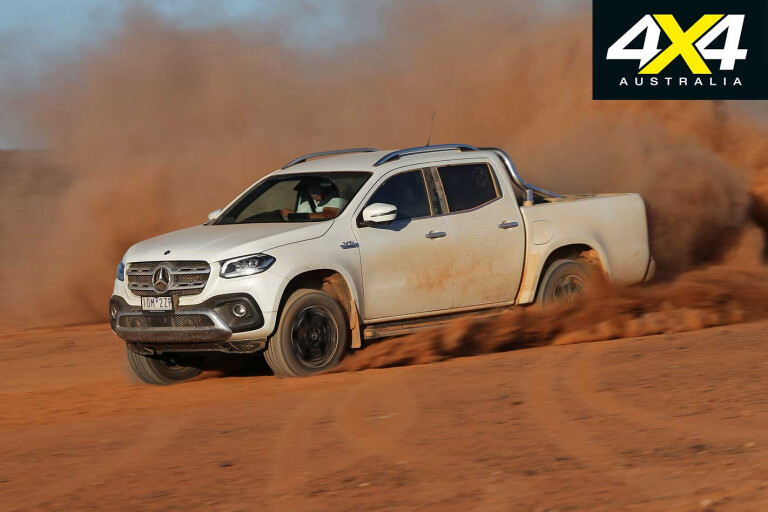
IT’S NOT even a year on the market and already the X-Class family has expanded to include the vehicle many have been anticipating, the one with a V6 engine. While the X250d uses a proven Nissan/Renault four-cylinder powertrain, the X350d keeps things in-house, utilising a 3.0-litre all-Benz V6 also used in various other Mercs.
It’s an engine with pedigree, then, and one planned to broaden the appeal of a vehicle that’s got off to a slow start in the sales race, the price premium no doubt deterring the ute faithful; for every X sold Toyota shifts about 20 Hiluxes. But the V6 injects some much needed German flavour.
It’s only available as a Progressive or Power specification, leaving the base model with only four-cylinder propulsion. Spec levels for the 350d are almost identical to the 250d, with the emphasis instead on the drivetrain.
Powertrain and Performance
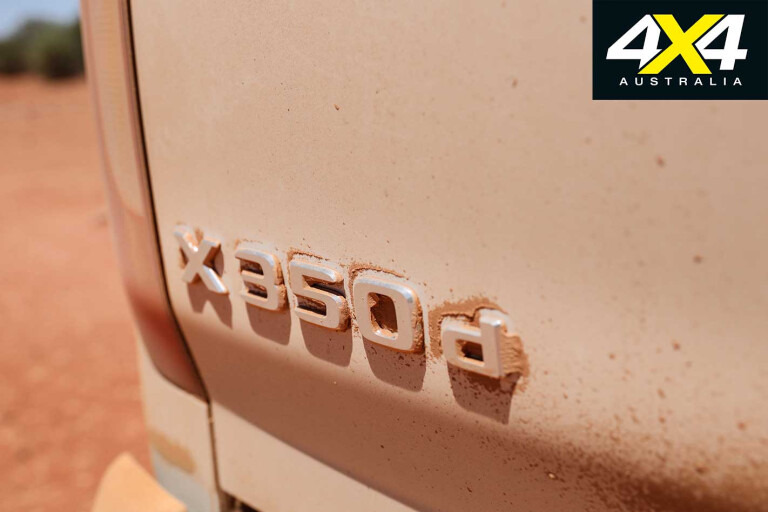
OTHER than the badge, there’s not much to pick the X350d from the X250d from the outside, but pop the bonnet and those numbers add up to big changes. All of which injects more three-pointed-star flavour into a car known for its Nissan genes.
The 3.0-litre V6 diesel is thoroughly Mercedes-Benz, also appearing in more fancied luxury kit including limousines and luxury SUVs. It also drives through a unique seven-speed transmission matched to a full-time 4x4 system.
It’s mostly good news on paper, the Benz’s 3.0-litre V6 good for 190kW and 550Nm. Not that much of it counts here. Sucking in outback dust is a reminder that durability and ruggedness are mandatory in these conditions. During our few thousand kays there was no hint of a stutter, the big Benz soldiering on stoically.
But it’s not perfect, the engine feeling flat when you first press the accelerator. It thinks, pauses, thinks some more then (finally) goes. Okay, so we’re exaggerating, but there’s pronounced lag that requires an adjustment of driving style in stop-start conditions.
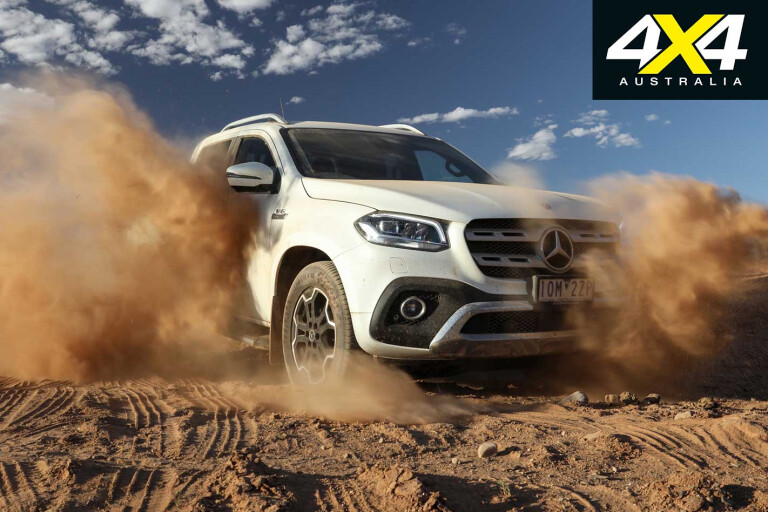
When it goes, it goes – big time – the 550Nm rush of energy launching towards the horizon with intent. Benz claims it’ll hit 100km/h in 7.9 seconds, which is 0.6 seconds slower than the Volkswagen. Our own testing suggested the gap wasn’t quite that large, but there’s no question the Amarok is brisker initially. On the run the lag is less of an issue, the broad bulge of torque always ready to react and the free-revving nature making building pace a snip.
That it does it so effortlessly and with the sort of refinement befitting a luxury car is a bonus. Things get better with speed, the X350 clearly content with some additional pace. While the likes of Australia and Africa were key development grounds for the X-Class, it’s clear an autobahn thrash (or two) was somewhere in the development mix. It was tempting to head north into the Territory to stretch the X-Class’s legs on the 130km/h open roads.
Whereas the Benz trails the Volksy on its initial take-off, it claws it back as speed increases, its ratios more closely spaced to keep the engine in its sweet spot. For overtaking the Merc feels the brisker machine, its lighter frame adding to a sense that you’ll never be lacking for punch. That sentiment is confirmed with some performance testing, the Benz shaving three-tenths off the Amarok for the 80-120km/h dash. That it does it with refinement and poise adds to its talent.
On-road
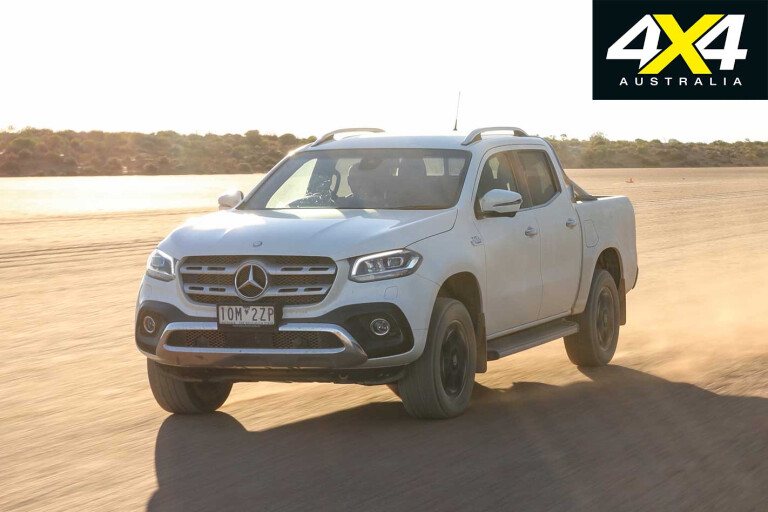
IF IT’S comfortable touring you yearn for then the Benz mounts a solid early case. Refinement is class leading, the X-Class eating up country roads and making light work of high-speed touring. This is a car that comfortably gets you there – in style. Its coil spring rear-end is also well behaved, the control in the suspension shunning washouts and large bumps while recovering quickly. Hit too hard and it’ll buck, but for the most part it deals well with the worst Australia can muster.
It’s no passenger car and there’s still a propensity to shudder over repeated imperfections, but it’s towards the pointy end of the ute paddock. The steering isn’t as convincing, although some weight mid-turn adds confidence. Brakes, too, could do with better progression, but with discs all around it stops confidently, even after repeated hard hits.
Ultimately, though, it’s the refinement and quietness that define the X-Class, setting a new class benchmark.
Off-road
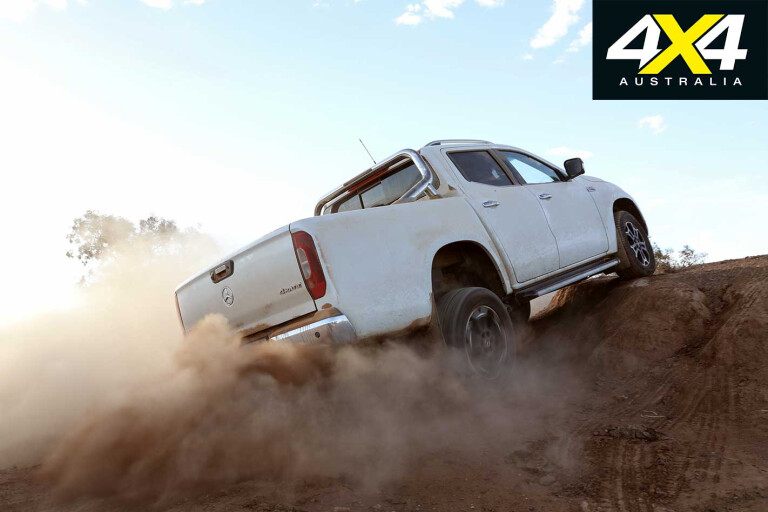
WHILE it may have hints of city slicker to its image, the X-Class comes with the hardware to get down and dirty. For starters, there’s a proper low-range transfer case; the additional crawler ratios allowing for easier slow-speed going.
Everyday driving splits 60 per cent of the drive to the rear. Locking the centre diff in high or low range evenly apportions drive front-to-rear and readies the car for more serious terrain. With wheels hanging in the air it swiftly sorts out where to send drive, the traction control chiming in when needed.
Yet it is engine response that remains an issue, no matter which 4x4 mode you’ve chosen. Blame it on throttle response, with the fast-swelling torque delivery making slow speed stuff hard work. There’s an Off-Road mode as part of the Dynamic Select system, unique to the X350d, which is designed to smooth the torque delivery, but you’ll still need to be gentle with the right foot.
Crawling along the craggy Mount Samuel track through Alpana Station highlighted the issues, the jump to 550Nm often too severe to give the rocky surface the respect it deserves.
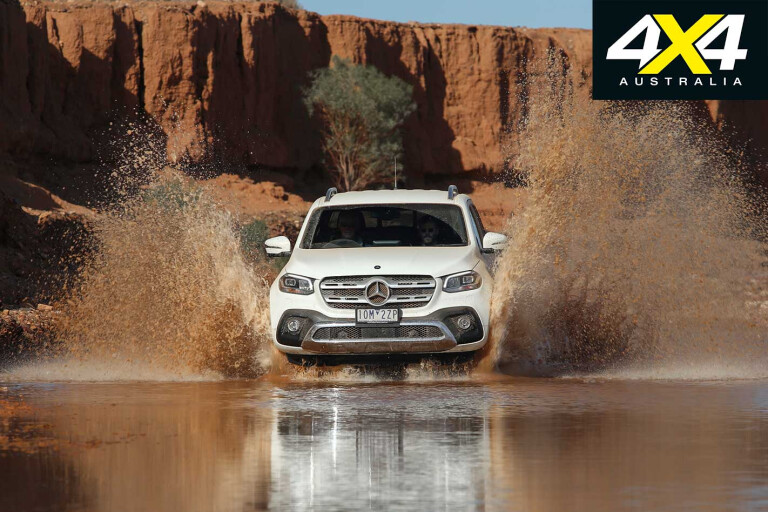
That laggy throttle response is no fun in the steep, go-slow terrain, where the all-or-nothing torque delivery makes delicate manoeuvres all the more delicate. It’s subdued somewhat in low range, but more work needs to be done to turn a luxury diesel into a competent off-roader.
Which is a shame, because the X-Class comes primed for the challenge. Its clean snout allows for more serious attacks than the Amarok, albeit with care to ensure that chrome-infused bumper doesn’t end up a casualty. While the tail is susceptible to scraping, it’s less exposed than the Amarok. Similarly, while the optional side-steps are exposed, there’s a full 222mm of ground clearance.
Cabin and Accommodation
THERE’S no hiding the Nissan roots inside the X-Class. While Mercedes has tried to inject plenty of its own DNA – the COMAND controller and instrument cluster among the highlights, as well as the badge on the steering wheel – the mainstream giveaways are there, from some of the plastics to the electric seat adjustments hidden out of sight beside the cushion rather than standing proud on the door.
Those front seats are comfortable but could do with more lateral support, and the steering wheel cannot be moved in and out, reducing adjustability to the driving position. They’re little things, but things likely to be noticed by those with a full-blooded Benz parked alongside in the garage.
Thankfully the broad themes scream Merc elsewhere and there’s an upmarket flavour from materials to the finishes. The X-Class certainly has a more premium look and feel to its cabin. And, while the aluminium trim across the dash can catch the glare of the sun occasionally, it otherwise teams with the circular air vents to create a dash with more visual flair than its German rival.
It’s a shame the dash is more looks than substance. Other than door pockets and a small space ahead of the gear selector, there’s almost nowhere to stash odds and ends. That the world’s oldest carmaker, responsible for some of history’s most impressive machines, can unleash a car with so little storage is gobsmacking. The X’s cabin storage is not just below par, it’s downright poor.
Rear-seat space is also compromised, mainly because of the high seat base that makes headroom a challenge for tall folk. At least there are rear air vents to better circulate coolness throughout.
What you get
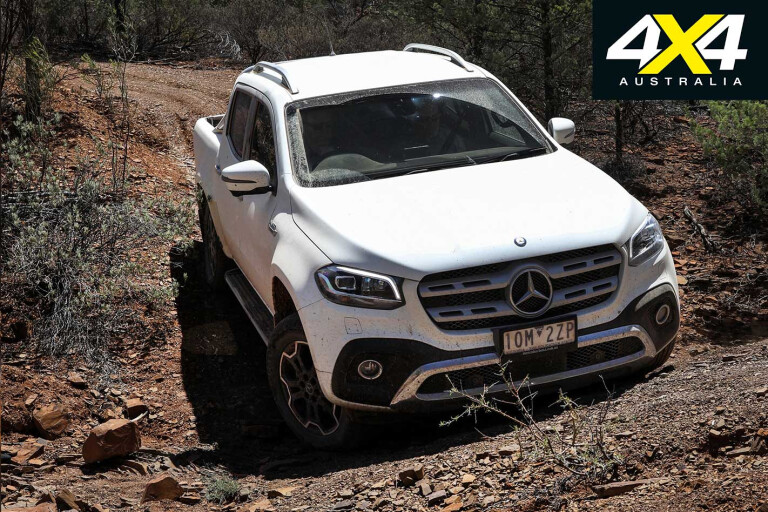
MERCEDES-BENZ may be playing in the mainstream workhorse space, but it’s arrived with a price premium befitting the three-pointed badge with the X-Class. Even the four-cylinder costs thousands more than rivals, and the auto-only V6 is a hefty $15K leap over the four-cylinder. For the flagship Power model tested here, that amounts to $79,415, prior to on-road costs. Ouch!
For that, you get the superior drivetrain with a permanent 4WD system and locking diffs.
Generally, though, the X is well appointed, although fake leather is standard, the real stuff adding $1750 to the price and heated seats $590. Other items left to the options list include a sports bar, side-steps and tow bar, all things buyers of Fords and Toyotas expect at much less money than this.
It seems Benz realised it had a value problem. So, until the end of March, all V6 buyers have a choice of $5000 of accessories.
That the warranty protection expires after three years is a disappointment, too, but on the safety front it’s class leading, with seven airbags contributing to excellent occupant protection.
Practicalities

THE X-CLASS is around 60mm wider than the Navara it’s based on, but 34mm narrower than the Amarok. So, while the tray is wide, capable of carrying a pallet between its wheel arches, the Amarok’s is slightly wider. Not that you’ll be disappointed with the space on offer; and there’s a few extra millimetres to the length, making it easier to sneak large items in.
It appears Mercedes was inspired by some of the Amarok’s thoughtfulness, including the LED light that illuminates the tray. It’s a handy extra for campers, as is the 12V power outlet in the tray. But the X is rated to carry more than a tonne, its 1010kg payload a clear leader.
That its coil spring rear-end sags sadly suggests no one would want to be carrying such loads for too long. Besides, any people and their luggage in the cabin detract from that carrying capacity. A superior GCM of 6180kg – 180kg more than the Amarok – makes it easier to explore the claimed 3.5-tonne tow capacity.
Even so, once you’ve got that much out back the payload is reduced to 490kg. Account for a towball download of around 300kg and you’re limited to a driver and some well-packed luggage.
Volkswagen Amarok Ultimate 580

THE AMAROK has long been a favourite at the 4X4 Australia office for its all-round ability and value. It’s great on-road and surprising off it. While it’s a relative newcomer to the dual-cab fight, from day one the Amarok has been a serious and well-regarded contender.
Enter the 580, another tempter for the top-end Ultimate trim level. As well as trinkets and gadgets, the 580 badge denotes more grunt from the tweaked 3.0-litre V6 turbo-diesel. It makes the 580 the most powerful ute in its class, perfectly timed to leap-frog the X350d before it even arrived.
Powertrain and Performance

THE V6 has been a winner for the Amarok, accounting for 70 per cent of sales. Those prepared to stump up the big bucks for the Ultimate are now rewarded with a higher tune, badged 580. That power tempter is expected to up the V6 sales split even further. The three numbers refer to the peak torque output, a 30Nm bump on the regular V6, and the same jump over the X350d. Like the Benz, that peak arrives down at 1400rpm.
Combined with a short first gear the Amarok is a sweeter thing jumping from a standstill. Compared with the Benz’s wait-for-it take-off, the Amarok feels poised to pounce, any right leg movement rewarded sooner.
Power is rated at 190kW, matching the Merc to the kilowatt. But the 580 has a 10-15kW trump card in the form of an overboost function that operates for up to 10 seconds, upping power to 200kW – or, in some instances, 205kW. It’s designed to work predominantly in third and fourth gears, between 50 and 120km/h.
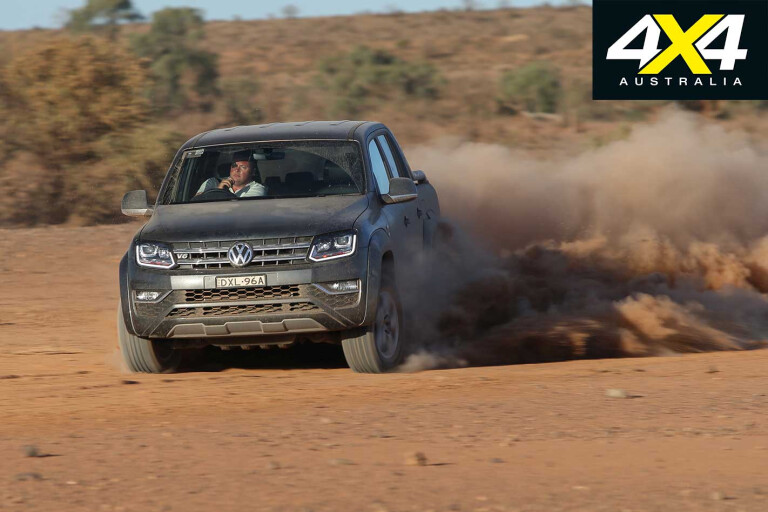
Fortunately third and fourth gears are in the sweet spot of usability. Given the closeness of the eight ratios, third tops out about 85km/h and fourth is done by 110km/h. So, for overtaking, you’re pretty much guaranteed the full 200kW muscle. There’s no discernible difference to the output of the engine, although it pulls strongly when you need it most.
That said, we were driving regularly in 40-plus-degree heat, which would all but guarantee intake temperatures above 55˚C, at which point the overboost functionality is automatically cancelled. Still, it’s a strong engine, and one that never feels lacking in power.
Its upper ratios are all tuned predominantly for fuel economy, something that gives the Amarok an advantage when cruising around 100km/h. The official figure is 8.5L/100km and it’s easy enough to hit that.
On-road
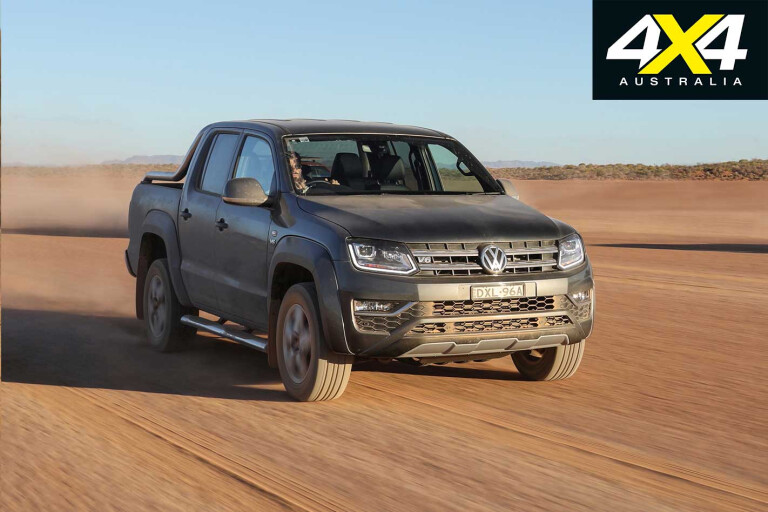
THE AMAROK does play with a proven dual-cab formula: live axle, leaf-sprung rear-end, independent coils up front sitting on a separate chassis. But from a company that had never produced a ute prior to 2010 (yep, the Amarok is well past middle age!), the Amarok showed the big boys how to do it better.
Nothing’s changed in 2019, except the Amarok is now up against a luxury rival that replaces those rear leafs with coils. Yet the Amarok holds its own beautifully, competently dealing with 100km/h bitumen and behaving predictably in the bends. It effortlessly flushes deep dips and recovers neatly, its tail not fluttering over repeated bumps, either.
The biggest deficit the Amarok gives away is in refinement, the general mechanical noises and tyre roar not at the low levels managed by the Mercedes. Less of an issue on gravel and low-speed dirt, but noticeable on those coarse-chip country roads Australian councils do so well. It makes up points with precise, predictable steering that’s nicely weighted. The brakes, too, are progressive and powerful, the rear discs contributing to consistent stopping power.
Off-road

OFF-ROADERS have long argued a transfer case is a prerequisite for rough-road driving, but the Amarok has done a top job of dispelling that. The 580’s high range-only ratios do little to slow progress in 99.9 per cent of what the average Aussie adventurer will encounter. It’s helped by its suitably low first gear and an off-road mode that adjusts the throttle sensitivity to make it easier to feed on torque, something achieved without panic.
While there would have been times low range would have been appreciated during our journey, nothing we tackled stopped the Amarok from ascending with relative ease. It’s helped by decent traction control and the backup of a locking rear diff, all of which ensures some short-term scrabbling is followed by forward progress.
Side-steps are never a good mix and it didn’t take long for the Amarok’s to hit the dirt. They’re uselessly low and prone to bending once they come into contact with anything but a foot.
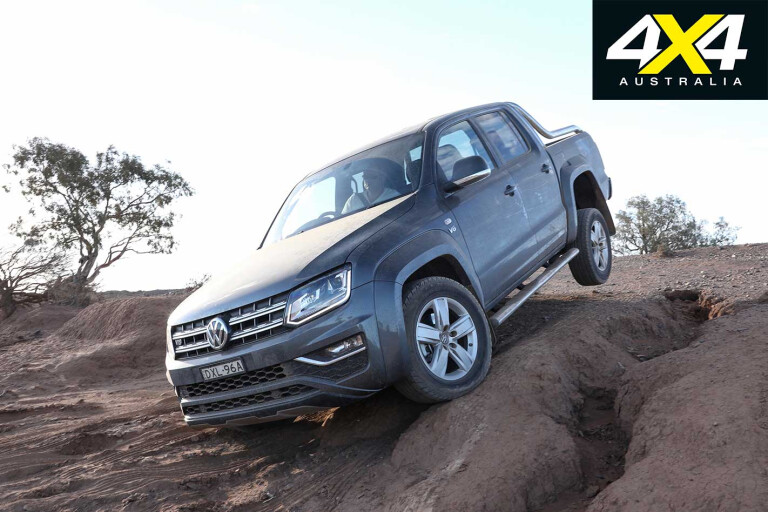
Best to assume they’ll be a casualty on the first trip and budget for some decent rock rails as a replacement. Also, those side-steps reduce the claimed clearance from 226mm to 192mm; so the on-paper benefit of the X350d is not as high once you factor in its optional side-steps.
Where the Amarok does shed points is in hilly or rocky terrain, its overhangs slightly loftier than the Merc’s, ever keen to scrape and tickle the underside. The departure angle, in particular, made for some bum-scraping moments out of sharp crevices.
Get into deep water, and the 500mm wading depth is 100mm shy of the Benz.
Cabin and Accommodation
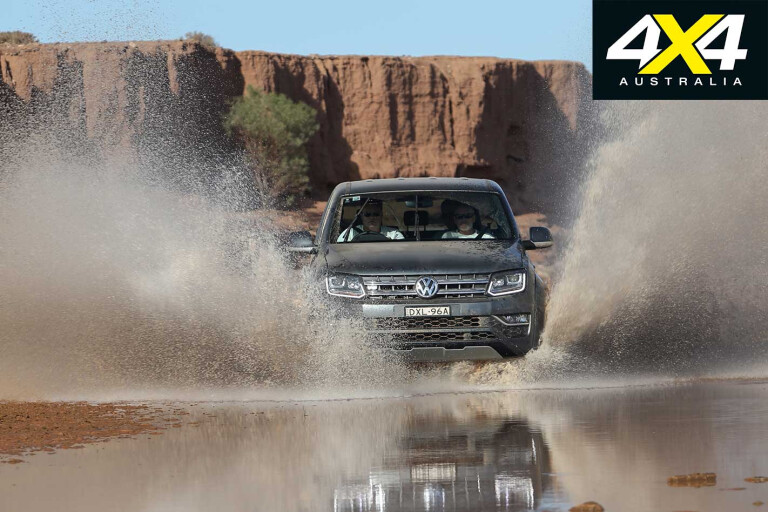
GETTING comfortable in the driver’s seat is easy in the Amarok. Terrific front seats make for great support and comfort, a step ahead of the Merc for lateral support. No matter how far you’re travelling, the pews aren’t likely to be an issue.
The relationship between pedals, seat and wheel is also more car than truck, adding to that sense of control and comfort. The controls are more logically presented than its cross-country rival, too, with a trio of ventilation dials positioned closely to the audio controls surrounding the central screen.
Then there’s the thoughtfulness elsewhere, particularly with storage. Where you struggle to find anywhere for a phone in the X-Class, in the Amarok there’s a smorgasbord of hidey holes and binnacles for everything from gadgets to maps. Even chronic over-packers will be well catered for in an Amarok.
Where the cabin falls down is in its presentation. The dash plastics are aesthetically pleasing from a distance, but have a hard scratchiness to the surfaces that diminishes the appeal. It’s way off the high bar set elsewhere in a VW dealership and even falls flat against many cheaper ute rivals.
Sure, there are felt linings to the door pockets, among other touches, but some extra effort on plastics and finishes would transform the Amarok. There are also some omissions, such as air vents to the rear.
Everywhere else, though, the Amarok’s rear space is a more welcoming place, the extra cabin width making it easier to accommodate three derrieres. Legroom isn’t as forthcoming, though.
What you get
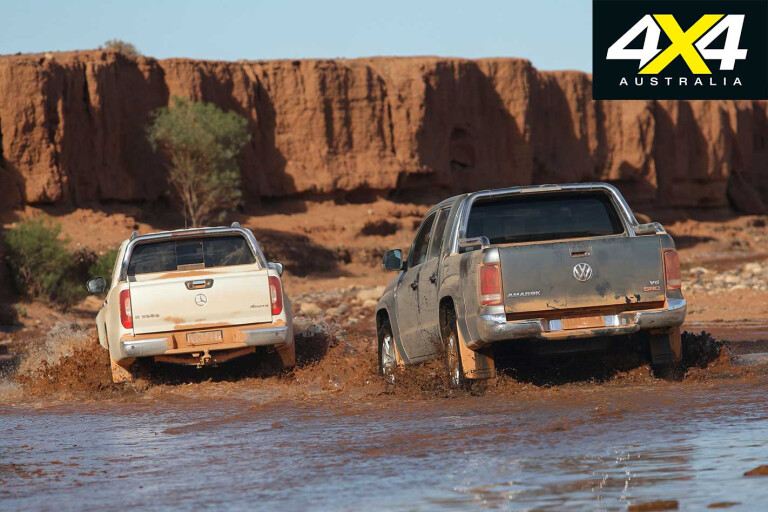
At $71,990 the Ultimate 580 tops the Amarok lineup. No wonder, then, that it’s lavished with gear, adding things such as alloy pedals, electric front seats, shift paddles, an extended sports bar and steel side-steps with LED lights incorporated to illuminate the ground. A mix of real and faux leather also coats the seats, which are heated up front.
Air-con temps can be split on either side of the car and the windows have been tinted. There’s also a reversing camera, auto windscreen wipers, sat-nav, parking sensors front and rear, and tyre pressure monitors. Infotainment is taken care of with a 6.3-inch touchscreen incorporating Apple CarPlay and Android Auto. Plus, there are 20-inch alloys, although you can downsize to 18s or 19s.
But not everything is included. To pay that much and still have to put a key in the ignition is something of a kick, especially as rivals serve up smart keys at a much lower price point. Then there’s the safety systems, which drag the Amarok down. It’s the only ute without rear airbags, for example, something that can mean the difference between life and death in a side impact crash. And, whereas auto emergency braking is filtering into other utes, including the X-Class (and all Volkswagen passenger cars), it’s not yet offered in the Amarok.
While they may not be deal-breakers, they expose the Amarok as undernourished in this company. At least the price partially reflects that.
Still, despite the on-paper advantage, value is not a word that really comes into the equation with the Ultimate. This is expensive dual cab motoring, with gaping holes. At least the Amarok is backed by a five-year warranty, outdoing the Mercedes by two years.
Practicalities

IT’S A BIG car with a big tray, and that’s one area the Amarok wins out. The extra width of the cabin also flows through to the tray, which can take a pallet between its wheel arches. While it doesn’t stretch as long as the X350, the additional width makes it a thoroughly useful ute; plus there’s a 12V outlet.
The Amarok’s 836kg payload may be almost 150kg down on the X’s, but we’d have far more confidence in its leaf springs being loaded to that limit. While we didn’t try it, experience suggests an Amarok does a better job with big loads on board.
Towing is a different story. While the Amarok V6 is rated to tow 3500kg, the 6000kg GCM reduces the payload to 256kg if you’ve maxxed things out. Considering the towball download will be at least that and you soon won’t even be able to legally drive it once you take a seat. Limit the tow capacity to 3000kg and the equation is more realistic, although payload will again become an issue.
Conclusion

THEY’RE top-end price tags with brawny V6 pull. After a couple of thousand kays it’s apparent neither the Amarok Ultimate 580 nor X350d is a true top-end ute. The only area they’ve moved the ute game on is in building speed. In other areas – particularly value – this duo falls flat. There are better off-roaders and more spacious utes, and both miss out on equipment that is standard on utes $20K cheaper.
Still, here we are, staring at a decent run back into town tasked with choosing a winner.
Some will struggle to overlook the noticeable safety deficit of the Amarok. The lack of curtain airbags and auto braking is tough at this price, especially when Volkswagen stuffs that same tech into $20K city hatchbacks. If you’re one who values safety as mandatory, then look no farther than the X-Class. It’s a fine truck and one that leads on refinement.
With the backing of a low-range transfer case and better raw ability, the X350d is also more convincing in very rough terrain. But the Amarok matches off-road pace in most situations – and in other areas it kicks back – hard. Its drivetrain is sweeter and more flexible, the extra ratio and lower first gear providing more consistent drive across the rev range and picking up sooner when you plant your foot.
Throw in sharper value – and more features – and the Amarok is an easy match for the X. It’s not perfect, but in the V6 power war the Amarok Ultimate 580 has taken an early victory.
Specifications
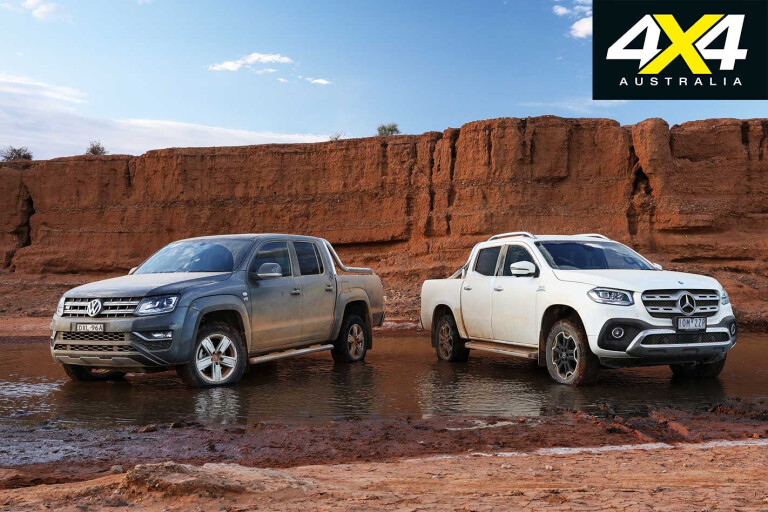
| Volkswagen Amarok Ultimate 580 | Mercedes-Benz X350d | |
| Engine | 3.0-litre V6 turbo-diesel | |
| Power | 190kW @ 3250-4500rpm | 190Kw @ 3400rpm |
| Torque | 580Nm @ 1400-3000rpm | 550Nm @ 1400-3200rpm |
| Gearbox | 8-speed automatic | 7-speed automatic |
| 4x4 System | High-range full-time 4WD | Dual-range full-time 4WD |
| Crawl Ratio | 15.44:1 | 42.61:1 |
| Construction | Separate-chassis | |
| Suspension (f) | Independent double wishbones, coil springs | |
| Suspension (r) | Live axle, leaf springs | |
| Kerb Weight | 2244kg | 2190kg |
| GVM | 3080kg | 3250kg |
| Payload | 836kg | 1010kg |
| Towing capacity | 3500kg | |
| GCM | 6000kg | 6180kg |
| Fuel capacity | 80 litres | |
| ADR fuel claim | 8.5L/100km | 8.8L/100km |
| L/W/h | 5254/1954/1834mm | 5340/1920/1839mm |
| Wheelbase | 3095mm | 3150mm |
| Price | $71,990 | $79,415 |
Glaring omissions
DESPITE their big ticket price tags, neither car stands out for its feature set, missing out on key items in more affordable rivals. A sunroof, for example, is not available in either and a tow bar is extra cost. Each then has big holes in its features – the Amarok’s lack of auto braking, for example, and the X’s lack of standard leather and heated seats.

COMMENTS